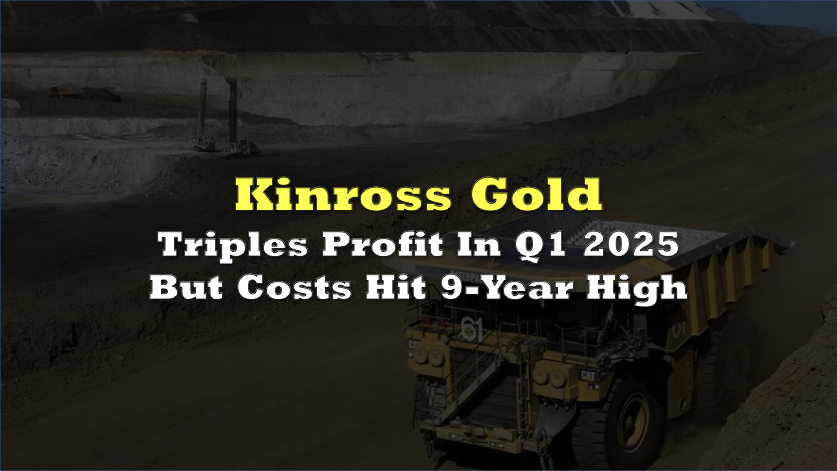Kinross Gold Corporation (TSX: K) has released its Preliminary Economic Assessment (PEA) for the Great Bear project in Ontario, with a projected net present value (NPV) of $1.9 billion at a $1,900 per ounce gold price.
Located in the Red Lake Greenstone Belt, 24 kilometers from Red Lake, Ontario, the Great Bear project is positioned within one of Canada’s most prolific mining regions. Kinross Gold’s acquisition of the Great Bear project was driven by its belief that the property could evolve into a world-class mining operation. The PEA supports this thesis by demonstrating the potential for both open-pit and underground mining, along with production capacity exceeding 500,000 ounces of gold per year in its initial years.
“This PEA marks an important milestone for Great Bear and reaffirms our view of it as a high-quality asset with robust economics and a clear path to becoming a world-class operating mine,” said Paul Rollinson, CEO of Kinross Gold.
At a base gold price of $1,900 per ounce, the Great Bear project boasts an internal rate of return (IRR) of 24.3% and an after-tax NPV of $1.9 billion. These figures improve further with higher gold prices, as demonstrated by a 35.5% IRR and an NPV of $3.3 billion at a gold price of $2,500 per ounce.
Back in December 2021, Kinross Gold made headlines with its $1.4 billion acquisition of Great Bear Resources and its Dixie project. The deal included a mix of cash and Kinross shares offered to Great Bear Resources shareholders.
Production costs are notably competitive, with average cost of sales estimated at $594 per ounce and all-in sustaining costs (AISC) projected at $812 per ounce over the life of the mine. This positions Great Bear as a high-margin operation, especially during the first eight years when production will average over 500,000 ounces annually.

The initial mine life is estimated at 12 years, with a total of 5.3 million ounces of gold expected to be produced. During the first eight years, Kinross plans to run both open-pit and underground operations concurrently, maximizing production flexibility and allowing time for further underground exploration to potentially extend the mine’s life.
Kinross has released an updated mineral resource estimate, increasing the inferred resource by 568,000 ounces, bringing the total inferred resource to 3.9 million ounces. The measured and indicated resources remain at 2.7 million ounces. These numbers are based on extensive drilling that has revealed high-grade mineralization at both surface and depth. Kinross’ exploration strategy includes continuing drilling at greater depths, with recent results suggesting significant upside potential for resource expansion.
The processing plant has been designed with simplicity and high margins in mind. Kinross will employ a conventional milling circuit, with a capacity of 10,000 tonnes per day, targeting an average grade of 3.87 grams per tonne. The projected recovery rate of 95.7% is indicative of the clean metallurgy identified during testing, which further de-risks project construction and execution. The selected processing method includes semi-autogenous grinding (SAG), ball milling, gravity concentration, and carbon-in-pulp adsorption, with the final product being gold doré.
The total capital expenditure for the initial construction phase is estimated at $1.2 billion, with an additional $250 million earmarked for capitalized mine development. This includes costs associated with mining the Viggo pit during construction, which will serve as an in-pit solution for tailings storage and provide low-cost mill feed in the early years.
The company has highlighted its strong balance sheet and expects to advance the project’s construction in 2024, pending the receipt of necessary permits.
In line with modern environmental standards, Kinross has integrated advanced tailings management technologies. A desulphurization flotation circuit will be employed to eliminate sulphides and prevent the generation of acid mine drainage. Additionally, tailings will be stored in an in-pit facility, removing the need for tailings dams.
Kinross said it is also committed to adhering to rigorous environmental and safety standards, further mitigating risks associated with the project. The company has also been engaging with local Indigenous communities, including Lac Seul and Wabauskang First Nations, with the goal of establishing long-term agreements that respect traditional land use.
Surface works are expected to begin in 2024, subject to receiving the necessary provincial permits. Kinross is also preparing for underground exploration, which will provide further insights into the project’s full potential.
Kinross Gold last traded at $11.56 on the TSX.
Information for this briefing was found via Sedar and the companies mentioned. The author has no securities or affiliations related to the organizations discussed. Not a recommendation to buy or sell. Always do additional research and consult a professional before purchasing a security. The author holds no licenses.









